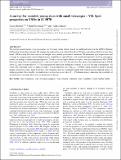Files in this item
A survey for variable young stars with small telescopes VII. Spot properties on YSOs in IC 5070
Item metadata
| dc.contributor.author | Herbert, Carys | |
| dc.contributor.author | Froebrich, Dirk | |
| dc.contributor.author | Scholz, Aleks | |
| dc.date.accessioned | 2023-03-15T17:30:08Z | |
| dc.date.available | 2023-03-15T17:30:08Z | |
| dc.date.issued | 2023-04-01 | |
| dc.identifier | 283384291 | |
| dc.identifier | 5fb2759f-0e3d-4aeb-ab78-e967c8819176 | |
| dc.identifier | 85159339777 | |
| dc.identifier.citation | Herbert , C , Froebrich , D & Scholz , A 2023 , ' A survey for variable young stars with small telescopes VII. Spot properties on YSOs in IC 5070 ' , Monthly Notices of the Royal Astronomical Society , vol. 520 , no. 4 , stac3051 , pp. 5433–5445 . https://doi.org/10.1093/mnras/stac3051 | en |
| dc.identifier.issn | 0035-8711 | |
| dc.identifier.other | Bibtex: 10.1093/mnras/stac3051 | |
| dc.identifier.uri | https://hdl.handle.net/10023/27190 | |
| dc.description | Funding: This work was supported by the Science and Technology Facilities Council. | en |
| dc.description.abstract | We present measurements of spot properties on 31 young stellar objects, based on multi-band data from the HOYS (Hunting Outbursting Young Stars) project. On average the analysis for each object is based on 270 data points during 80 days in at least 3 bands. All the young low-mass stars in our sample show periodic photometric variations. We determine spot temperatures and coverage by comparing the measured photometric amplitudes in optical bands with simulated amplitudes based on atmosphere models, including a complete error propagation. 21 objects in our sample feature cool spots, with spot temperatures 500 – 2500 K below the stellar effective temperature (Teff), and a coverage of 0.05 – 0.4. Six more have hot spots, with temperatures up to 3000 K above Teff and coverage below 0.15. The remaining four stars have ambiguous solutions or are AA Tau-type contaminants. All of the stars with large spots (i.e. high coverage >0.1) are relatively cool with Teff <4500 K, which could be a result of having deeper convection zones. Apart from that, spot properties show no significant trends with rotation period, infrared excess, or stellar properties. Most notably, we find hot spots in stars that do not show K − W2 infrared excess, indicating the possibility of accretion across an inner disk cavity or the presence of plage. | |
| dc.format.extent | 13 | |
| dc.format.extent | 1438668 | |
| dc.language.iso | eng | |
| dc.relation.ispartof | Monthly Notices of the Royal Astronomical Society | en |
| dc.subject | Stars: formation | en |
| dc.subject | Stars: pre-main-sequence | en |
| dc.subject | Stars: star spots | en |
| dc.subject | Stars: variables: T Tauri, Herbig Ae/Be | en |
| dc.subject | Stars: rotation | en |
| dc.subject | QB Astronomy | en |
| dc.subject | QC Physics | en |
| dc.subject | 3rd-DAS | en |
| dc.subject | MCC | en |
| dc.subject.lcc | QB | en |
| dc.subject.lcc | QC | en |
| dc.title | A survey for variable young stars with small telescopes VII. Spot properties on YSOs in IC 5070 | en |
| dc.type | Journal article | en |
| dc.contributor.institution | University of St Andrews. School of Physics and Astronomy | en |
| dc.contributor.institution | University of St Andrews. St Andrews Centre for Exoplanet Science | en |
| dc.identifier.doi | https://doi.org/10.1093/mnras/stac3051 | |
| dc.description.status | Peer reviewed | en |
| dc.identifier.url | https://arxiv.org/abs/2210.09895 | en |
This item appears in the following Collection(s)
Items in the St Andrews Research Repository are protected by copyright, with all rights reserved, unless otherwise indicated.

